Top News
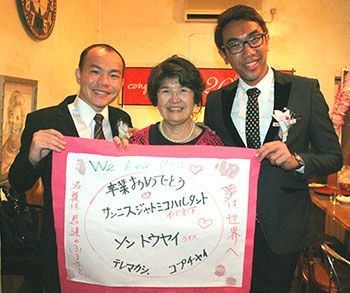
March 28, 2017 Ryukyu Shimpo
At the graduation and completion ceremony at the National Institute of Technology, Okinawa College in Nago on March 18, Aya Arashiro, 70, who runs the dining bar “Aya” in Nago, watched over two foreign exchange students. Arashiro has been supporting foreign exchange students from schools like the Okinawa College and Meio University as the “Mother of Nago,” before sending them off to their respective countries, since around 20 years ago.
The two students graduating from the Okinawa College this year are Sunny Sujatmiko Hartanto, 22, from Indonesia, who is graduating from the Machine System Engineering department, and Son Tuayai, 23, from Laos, who is graduating from the Biological Resource Engineering department. Arashiro looked after the two students by letting them stay at her house on the weekends, and introducing them to local people at the restaurant.
Arashiro said of the two graduates, “I am at the same time both happy to see them go on to do their best on their respective paths, and saddened to see them leave.”
Sujatmiko will be moving on to Toyohashi University of Technology in Aichi Prefecture to continue gaining knowledge and skills for another two years. He is looking to start his own business in the future, and was commended at the graduation as an exceptional student. [Sujatmiko] said to Arashiro, smiling, “I want to take my grandchild with me at some point. I don’t know when that will be though.”
Son has his sights set on the biotechnology world. As his home faces rapidly decreasing forests due to things like agricultural development, Son says, “I want to protect the environment.” He is planning on returning to his hometown in Xaisomboun Province, and put his skills to work in agriculture. He reflected, “In my three years in Okinawa, everyone was very nice. The weather in Okinawa is similar to Laos, so it was easy to live here.”
(English translation by T&CT and Sam Grieb)
Go to Japanese
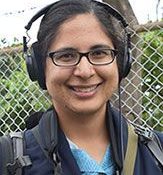
March 24, 2017 Ryukyu Shimpo
By Chie Tome
An American journalist, 37-year-old Sonia Narang, attended the prefectural people’s rally on March 25 opposing the construction of a replacement facility to Futenma Air Station in Henoko, Nago. Narang is investigating and reporting on the reality of U.S. military bases in Okinawa and the influence of women in today’s world. When she came to the front of Camp Schwab’s gate, she said that she wants to hear in person what the women at the front lines of the struggle have to say.
Okinawa military base issues get only negligible coverage by leading U.S. newspapers such as the New York Times and the Washington Post. Given that the U.S. is involved in the problems, the lack of American interest in these issues is worrisome. Narang said that there seem to be arguments for and against the base presence in Okinawa, as well as ignorance of it, but the worst of all is when people turn a blind eye.
Narang said that her self-assigned mission is to report extensively on the realities of the world. She plans to share the information and testimony she collected on her visit to Okinawa and Camp Schwab’s gate on Public Radio International’s program The World.
(English translation by T&CT and Erin Jones)
Go to Japanese
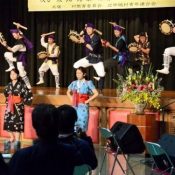
March 23, 2017 Ryukyu Shimpo
“Tohoku Eisa Project” , which consists of people from Young Men’s Association of Kitanakagusuku village, received a special award from the Japan Seinendan Council. The Japan Seinen OB Prefectural Assembly Prize for Encouragement is a special award from the Japan Community Seinen Implementation Awards granted by the council. A celebration was held at the Kitanakagusuku town hall on March 16, and the members celebrated the award with their village mayor and other members from the village. There was also a debrief session held to report on their trip to Tohoku to raise awareness for disaster prevention.
The Tohoku Eisa Project visited Minamisanriku town in Miyagi prefecture and Shinchi-town in Fukushima prefecture last August to raise the spirits of the disaster-affected communities. The performance was received with endless applause and a call for an encore from the audience.
The project was launched after members from Yorisoi Tai group which had been visiting the area since the disaster heard about residents’ wish to watch eisa.
The project raised funds performing at events, through donations, selling original towels, as well as receiving sponsorship from 121 business groups. The group hosts report meetings in all the town halls in the village to give back to the community.
A plan to send an eisa group to Kuzumaki-town was also announced during the celebration for the upcoming 30th anniversary of the sister-village-town relationship between Kitanakagusuku and Kuzumaki town in an effort to expand friendship among youth.
The leader of the project, Hikaru Kinjo smiled as he reflected, “A lot of people helped this project, and I’m relieved that this project is valued. We would like to send our eisa to many places.”
(English translation by T&CT and Sayaka Sakuma)
Go to Japanese
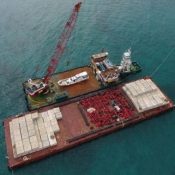
March 29, 2017 Ryukyu Shimpo
On March 28, the Okinawa Prefectural Government (OPG) ordered the Okinawa Defense Bureau (ODB) to suspend the submerging of concrete blocks into the sea, which is part of work to set up silt protectors for the construction of a new U.S. base in Henoko, Nago City. “The construction was proceeding without enough explanation to the prefectural government,” the OPG stated.
(A silt protector is a flexible membrane product that has been designed to physically prevent diffusion of pollution generated in dredging or reclamation works on the seas or rivers.)
The OPG asked the ODB to submit information concerning the plan to lay the pollution prevention membranes by March 31.
This is an administrative direction regarding the crushing of rock reefs, which was given legal approval by the Former Governor Hirokazu Nakaima. The OPG has taken this stronger step in response to the ODB continuing the work. Meanwhile, the defense bureau has expressed its view that the process to seek the permission of the OPG is no longer necessary because the fishery in the area of the planned new base has disappeared. The ODB will continue the work without following the OPG’s order.
The OPG will consider other legal measures such as looking at how the work is being carried out in Henoko.
The instruction issued by the OPG this time was on the basis of the conditions attached to the permission which the former governor gave to the ODB to crush the reef in the Henoko coastal area on August 28, 2014.
The conditions are as follows: (1) the ODB must follow further instructions that will be given by the OPG for the reason of fishery adjustment or other reasons related to the public interest. (2) it must provide materials without delay if the governor asks for explanation on the progress of the construction, and so forth.
The OPG has asked the ODB to explain the reasons for the difference between the contents initially approved by the prefectural government and those in the particular specification created afterwards on the plan to install the pollution control membranes, including submerging the concrete blocks.
Meanwhile, the ODB has been continuing the work, insisting that the current submerging work is being carried out based on the same conditions approved initially by the OPG, and that there is no change.
(English translation by T&CT)
Go to Japanese
March 24, 2017 Ryukyu Shimpo
On March 23, the Okinawa Prefecture Culture, Tourism and Sports Division announced that 15,399 couples had Okinawa resort weddings in 2016, a rise of 8.6 percent from the same period last year and the highest number in five consecutive years. The number of couples from Japan was 13,532, which was a 6.4 percent increase on the same period last year. The number of couples from overseas, which was 1,867, increased by 28.1 percent. Approximately 237,000 tourists visited Okinawa for resort weddings bringing an estimated 22.4 billion yen to the local economy. Both numbers hit a record high.
“Location photo (Photo wedding),” in which a couple takes photographs in nature spots such as the beach has been popular. The Okinawa Prefecture determined that the number of domestic visitors who chose Okinawa as a resort site without the need for a passport is increasing. Meanwhile, concerning overseas customers, increased recognition of “Legal weddings”( to be married based on local laws) has contributed to the boost.
“Chapel Wedding,” in which a couple has a wedding at a chapel was the most popular, accounting for 70 percent of the total number of couples. Photo wedding, in which a couple takes photographs only, accounted for about 30 percent. Legal weddings are carried out in 11 municipalities, with 141 couples in Yomitan Village being the largest, 107 couples in Onna Village, and 60 couples in Kunigami Village. Although it is still as low as 3 percent, the demand for beach weddings, restaurant weddings, and uninhabited island weddings is also increasing.
By region, domestic applicants from the Kanto region are the largest at 30.9 percent, followed by Kinki region at 20.2 percent, and the Chubu region at 16.7 percent. As for overseas, Hong Kong accounted for the largest number with 57 percent, 29.4 percent from Taiwan, 7.6 percent from China, and 2 percent from Korea. Onna Village and Yomitan Village accounted for 43 percent of the total number of ceremony locations, followed by Chatan Town, Nago City, and Itoman City.
The survey was open to 62 affiliated enterprises in the prefecture dealing with resort weddings, and the figures of 55 companies who answered were collected.
(English translation by T&CT and Megumi Chibana)
Go to Japanese

March 16, 2017 Ryukyu Shimpo
Okinawa Governor Takeshi Onaga made comment on the permit for fracturing reef rock as part of base construction in Henoko on the morning of March 16. The permit for fracturing the reef will expire at the end of March, and the Okinawa Defense Bureau has informed that there will be no application made to renew the permit. The governor said “as Okinawa prefecture, we will consider any legal procedures including request for suspension of the operation if fracturing of the reef takes place without permission after April.” This is the first time for him to make comments about filing for a suspension.
The governor strongly criticized the bureau’s decision to make no application to renew the permit, “The latest case, Naha Airport, which follows the same process as the Henoko construction, made a renewal application. This decision by the bureau shows the country’s double standard, and it must not be allowed to happen.”
He also commented on the Fisheries Agency’s position which the bureau used as the justification for its decision, questioning the agency; “it is hard not to believe that the document prepared by the Fisheries Agency has been modified specifically for the Henoko case. The situation shows Japan is far from a law-abiding country, reflecting Japan’s hard-line approach.”
(English translation by T&CT and Sayaka Sakuma)
Go to Japanese
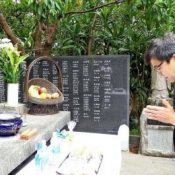
March 27, 2017 Ryukyu Shimpo
On March 26, 2017, 72 years after the “group self-determination” (compulsory group suicides) took place on Zamami Island during the Battle of Okinawa in 1945, villagers visited the Heiwa-no-To peace memorial and joined their hands in prayer.
The villagers pledged permanent peace and vowed never to repeat the misery of war again.
U.S. troops landed in Zamami Village on March 26, 72 years ago, and then Okinawa’s ground battle began.
Akikazu Nakamura, 61, who lost his father’s siblings in “group self-determination” said, “On March 26 and on June 23 (the Okinawa Memorial Day), I visit here every year and join my hands in prayer. I want to ensure permanent peace and pass it to our children’s generation.”
Kosei Miyazato, 80, who survived by hiding in a mountain during the wartime, while his family members died because of food shortages.
“Peace in the present day is built on the sacrifice of precious lives. I want the world to be a peaceful place forever,” he said.
Mayor Satoru Miyazato said, “Zamami Village has become a place where many tourists come to visit. But, there are many regular visitors who do not know about the Battle of Okinawa. Conveying the peace message is the mission of the village. I want to make it easier for many people to visit by maintaining the memorial tower and publishing a brochure. ”
On the day, people offered prayers freely because an official memorial service was not held.
The memorial service sponsored by the village is held once every five years and will be held again in 2020.
(English translation by T&CT)
Go to Japanese
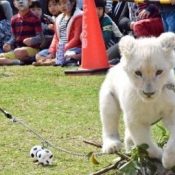
March 27, 2017 Ryukyu Shimpo
On March 26, at the Okinawa Zoo and Museum in Goya, Okinawa City, a welcome ceremony for a male white lion cub from the Tohoku Safari Park in Fukushima was held.
White lions are rare and can only be seen in eight zoos in the country. Many parents and children visited the zoo to see the cub.
When the cub appeared, the crowd cheered, saying, “Cute!” “It looks like a cat.”
The cub, only four months old, occasionally let out a little cry, and marched on a red carpet in a majestic manner, accompanied by Okinawa City Mayor Sachio Kuwae.
At the welcome ceremony, a lottery was held and the winners got to take part in a commemorative photo event with the white lion cub. The winners of the lottery enjoyed taking photos with the baby “King of Beasts”.
Nobushige Kumakubo, president of the Tohoku Safari Park, said, “We expect that this white lion will become an idol of Okinawa.”
Kumakubo handed a lead rope for the cub to the mayor.
The name of the cub will be decided by the public some time after April.
(English translation by T&CT)
Go to Japanese
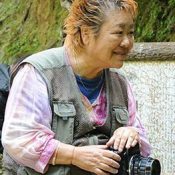
March 23, 2017 Ryukyu Shimpo
By Noriko Oshiro
Mao Ishikawa, a photographer who focuses on taking pictures of Okinawa and the people who live there, will be attending four in New York City from March 28 through April 2, including a publication signing event for her new photography book, a photography exhibit for an international art dealer association.
One of the events in New York is a photo exhibition showing the works of three Okinawan photographers: along with Ishikawa, the late Kenshichi Heshiki, and Ryuichi Ishikawa. Another event is the “Living Okinawa” symposium featuring Ishikawa, her aunt, Teiko Yonoha-Tursi, ex-head of the New York Okinawa Club, and Annmaria Shimabuku, Assistant Professor of East Asian Studies at New York University. Ishikawa will also be giving a talk on her own.
The photography book is titled, Red Flower, the Women of Okinawa, and is set to be published by Session Press this month. The book is a compilation of 80 photographs, including previously un-published pictures, taken from 1975-1977 in Koza and Kin, capturing women and American soldiers while Ishikawa was working in bars that serviced the American military. Miwa Suzuta from Session Press commented, “For some time I have thought that these fantastic photos are powerfully beautiful and vivid.” The company plans on issuing 600 copies of the book.
For the past four years, Ishikawa has been working on the, “Dai-Ryukyu Shashin Emaki,” which is a scroll of color photos printed on a roll of cloth. The project is expresses Ishikawa anger towards the history and current situation in Okinawa and is expressed with great satire, she is currently working on part four. This year, she was diagnosed with a quickly progressing stage 4 cancer. However, she continues to move full-speed ahead towards the “Ichi emaki-ten” in the fall. “I have mobilized the full force of my personal network built over 43 years of experience working as a photographer.” Her fierce view and persistent belief in Okinawa is expressed through her photography.
Red Flower can be purchased through the art photo book specialty distributor twelvebooks’ website, for 11,000 yen (plus tax).
(Translated by T&CT and Sam Grieb)
Go to Japanese
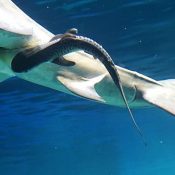
March 24, 2017 Ryukyu Shimpo
Roughly between noon and 4 p.m. on March 23, a tiger shark gave birth in a shark display tank at Churaumi Aquarium in Motobu Town. Tiger sharks live in ranges from the tropics to temperate zones, and this is the first time a tiger shark has given birth from breeding in captivity. The mother gave birth to about 30 baby sharks, ranging from 60 to 80 centimeters in length.
The female tiger shark was caught in a stationary net off the coast in Yomitan Village, and afterward her breeding at Churaumi Aquarium began. She conceived at the time, as was detectable by the swelling of her abdomen. The births took place in a tank containing several other sharks, so for the safety of the baby shark it was moved to a reserve tank outside of the aquarium, where the baby shark swam energetically.
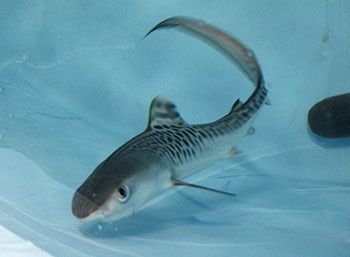
On March 23 at Churaumi Aquarium in Motobu Town, a baby tiger shark that was just born swims energetically.
During the birth, an announcement was made throughout the aquarium facilities that this birth was a “world-first” occurrence, drawing a large throng of people to the shark tank. Those who witnessed the birth of the baby tiger sharks applauded and cheered.
Atsushi Kaneko, who is involved in planning and public relations for Churaumi Aquarium, said that people are generally very familiar with sharks, although many things are still unknown about their ways of life. He thinks that elucidating this mystery through breeding is one role of an aquarium.
(English translation by T&CT and Erin Jones)
Go to Japanese
March 23, 2017 Ryukyu Shimpo
On March 22, Okinawa prefecture’s Department of Culture, Tourism and Sports published its numbers regarding inbound tourism between April 2016 and February 2017. Compared to the same timeframe from the year before, 7,990,700 more people visited Okinawa, which is a 10.6% overall increase. This means that the prefecture’s goal of reaching 8.4 million tourists during fiscal year 2016 is likely, if not guaranteed, to happen. If March 2017’s results are similar to 2016’s, which was about 700 thousand people, then the total is expected to greatly surpass the goal and reach about 8.7 million tourists.
The total number of domestic tourists between April 2016 and February 2017 was 6,020,000, which is a 5.7% increase. However, it was the 1,970,700 foreign tourists, a 28.6% increase, that pushed the total upward. Starting this April, T’Way Airlines will service Naha and Daegu, South Korea, while China Eastern Airlines will service Naha and Xi’an, China. These new routes are expected to attract more foreign tourists.
The prefecture’s Tourism Policy Division predicts the following: “From March onward, in addition to increased travel demands during spring break, airline companies are also seeing favorable trends in reservations. These good trends are expected to continue.”
The total number of inbound tourists for February was 637,900, or a 2.5% increase from the previous year, which is a new record high for the month of February. A new record high for each month of the year has occurred 40 months in a row, while surpassing numbers from the previous year on the same month has occurred 53 months in a row.
The total number of domestic tourists for February was 493,800, which is a 4.5% overall increase. 241,400 (+7.1%) were from Tokyo area, 97,200 (+1.8%) from Kansai area, 64,900 (-0.6%) from Fukuoka area, and 43,600 (+6.3%) from Nagoya area.
The total number of foreign tourists for February was 144,100, which is a 3.9 % overall decrease. The Chinese New Year falling in January this year, instead of February like last year, and cruise ships making fewer stops are what caused this number to fall below the previous year’s. The last time the total number of foreign tourists for the month fell below the previous year’s was three months ago. Of the total, 45,000 (+14.8%) were from South Korea, 43,600 (+37.1%) from Taiwan, 29,300 (-32.8%) from mainland China, and 11,100 (-20.7%) from Hong Kong.
(English translation by T&CT and Chelsea Ashimine)
Go to Japanese










 Webcam(Kokusai Street)
Webcam(Kokusai Street)


